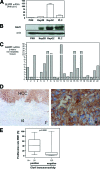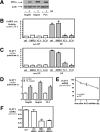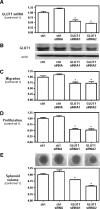GLUT1 expression is increased in hepatocellular carcinoma and promotes tumorigenesis
- PMID: 19286567
- PMCID: PMC2671384
- DOI: 10.2353/ajpath.2009.080596
GLUT1 expression is increased in hepatocellular carcinoma and promotes tumorigenesis
Abstract
Accelerated glycolysis is one of the biochemical characteristics of cancer cells. The glucose transporter isoform 1 (GLUT1) gene encodes a key rate-limiting factor in glucose transport into cancer cells. However, its expression level and functional significance in hepatocellular cancer (HCC) are still disputed. Therefore, we aimed to analyze the expression and function of the GLUT1 gene in cases of HCC. We found significantly higher GLUT1 mRNA expression levels in HCC tissues and cell lines compared with primary human hepatocytes and matched nontumor tissue. Immunohistochemical analysis of a tissue microarray of 152 HCC cases revealed a significant correlation between Glut1 protein expression levels and a higher Ki-67 labeling index, advanced tumor stages, and poor differentiation. Accordingly, suppression of GLUT1 expression by siRNA significantly impaired both the growth and migratory potential of HCC cells. Furthermore, inhibition of GLUT1 expression reduced both glucose uptake and lactate secretion. Hypoxic conditions further increased GLUT1 expression levels in HCC cells, and this induction was dependent on the activation of the transcription factor hypoxia-inducible factor-1alpha. In summary, our findings suggest that increased GLUT1 expression levels in HCC cells functionally affect tumorigenicity, and thus, we propose GLUT1 as an innovative therapeutic target for this highly aggressive tumor.
Figures




References
-
- El-Serag HB. Hepatocellular carcinoma: recent trends in the United States. Gastroenterology. 2004;127:S27–S34. - PubMed
-
- Farazi PA, DePinho RA. Hepatocellular carcinoma pathogenesis: from genes to environment. Nat Rev Cancer. 2006;6:674–687. - PubMed
-
- Bruix J, Boix L, Sala M, Llovet JM. Focus on hepatocellular carcinoma. Cancer Cell. 2004;5:215–219. - PubMed
-
- Kim JW, Dang CV. Cancer’s molecular sweet tooth and the Warburg effect. Cancer Res. 2006;66:8927–8930. - PubMed
-
- Brahimi-Horn MC, Chiche J, Pouyssegur J. Hypoxia signalling controls metabolic demand. Curr Opin Cell Biol. 2007;19:223–229. - PubMed
Publication types
MeSH terms
Substances
LinkOut - more resources
Full Text Sources
Other Literature Sources
Medical
Miscellaneous

